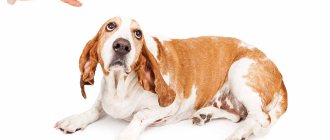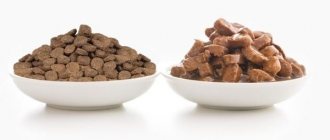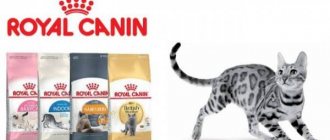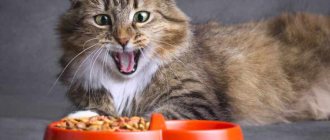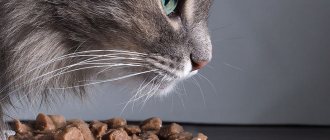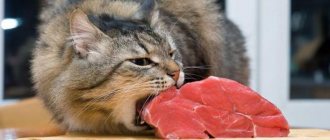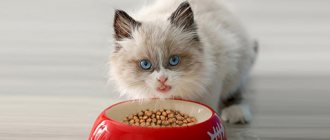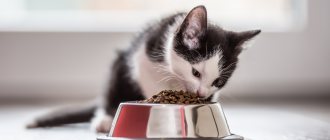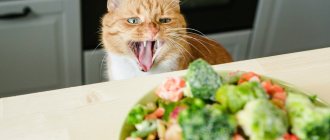Natural curiosity often leads a dog to the cat's bowl. There are cases when the owner himself gives her someone else’s food, forgetting to buy specialized food. But, despite the desire of the animal or the convenience of the owner, feeding a dog with cat food is strictly prohibited. Dog food manufacturers have long broken sales records by releasing a universal product for them. The limitation is due to several factors, primarily animals have different physiology and digestive systems.
Differences between cat and dog food
Food for completely different species of animals has a similar consistency, appearance and smell. It is the bright meat or fish aroma that attracts dogs to someone else's food. But these parameters are where the common features of the two types of feed end.
Speaking about the differences between the diets of cats and dogs, we should not forget about the structure of the digestive system of each animal. Representatives of the cat family are absolute predators. The share of animal protein in their food prevails over other components. Dogs are omnivores; along with meat, they need grains and vegetables.
High blood glucose levels in cats significantly affect the digestibility of foods. For them, small and frequent meals are a necessity. The dog does not need such a diet and it is enough to feed it 2 times a day.
The most significant differences are the following:
- in the composition of cat food, the manufacturer focuses on protein;
- Canines are recommended to regularly consume fiber;
- the required amount of animal protein for a dog is not less than 25%, cats need from 40%;
- the accelerated metabolism of cats requires more high-calorie food;
- the set of necessary minerals is also different: dogs require potassium, calcium and magnesium, cats need phosphorus more.
The compositions of the feed are similar only in the volume of fats of plant and animal origin and synthesized vitamin supplements. The listed differences are equally valid for dry food and various food bags.
The cat is an obligate predator
Both cats and dogs are carnivores, which means that the basis of their diet should be meat. In nature, they would feed on small animals, eating not only muscle meat, but also entrails, bones and cartilage.
However, in the process of domestication, dogs adapted to eat what humans offered them, and these were not always meat products, more often just leftovers from the human table. Even hunting dogs, trained to track and pick up game, end up not eating it themselves, but presenting it to the owner. Cats in village households were fed from time to time, thanks to which they always knew how to get food themselves. Fortunately, there are enough mice and birds everywhere.
As a result, modern dogs are better adapted to dietary diversity, in particular to the absorption of carbohydrates. Cats still remain strict meat eaters and do not tolerate plant foods well. Therefore, food for them should contain more protein components and less carbohydrates.
According to GOST “Feed for non-productive animals”, the lower threshold for crude protein content in cat food is:
- 30% - during the period of growth and reproduction;
- 26% - for adult animals from which they do not plan to produce offspring.
For dogs, these figures are significantly lower: 18 and 22%, respectively. Please note that these figures reflect only the extreme limit of the norm necessary for survival, and in order to fully cover the cat’s need for protein, it should be approximately 35–40% in dry food.
Why does a dog eat cat food?
There are several reasons for this interest. One of the most common is an attractive smell. It is a rare dog that can resist aromatic and flavoring additives combined with a high content of animal protein. Most often, low-price foods have an intense smell, and they are equally harmful to both animals.
A pet’s persistent desire to eat the neighbor’s food may indicate a lack of protein in its own diet. In this case, it is worth reconsidering the choice of food for your four-legged friend.
Common reasons for attacks on a cat's bowl include:
- food aggression and attempts to establish a dominant position in the house;
- tasteless, cold or poorly prepared food;
- lack of sufficient meat in the diet;
- constant open access to food;
- curiosity and desire to try new products.
Attempts to seize someone else's food are often made by very young animals. In this way, the dog can play with other pets or demand attention. It is also possible that the puppy quickly ate his portion and switched to cat food. A single use will not harm him in any way, but in the future such actions must be stopped.
This is interesting: Peculiarities of feeding dogs at different periods of life
Until what age is this food needed?
People often find it difficult to decide when to switch a kitten to adult food. Although everything is simple here. If you stick to one manufacturer's food, then it covers all ages with its products. All you have to do is read the instructions and find out up to what age your kitten food is intended. After this you need to move on to the next age category.
Usually you can switch to adult food after six months. From 8-12 months this definitely needs to be done. At this time, growth is already slowing down: there are no such big jumps as there were in 3-4 months. If you continue to feed an adult cat after a year with kitten food, he runs the risk of becoming fat. After all, food for kittens, as we have already said, is more nutritious. An adult cat doesn't need that much.
Rate and share!
The dangers of cat food for dogs
Stealing someone else's food not only harms smaller pets, but also causes damage to the offender's body. The composition and ratio of ingredients is selected in a special way and is suitable only for a certain type of animal. Regular use will cause serious consequences, including chronic diseases.
- Obesity. Physical activity and a faster metabolism help cats stay lean. It is important for them to have constant access to food, as they eat small portions. The dog digests food much more slowly, so the calorie content of the food should be lower. Otherwise, the risk of becoming overweight increases. This problem especially concerns castrated and sterilized animals.
- Allergy. Cat food contains taurine, gluten and some types of starch. If a dog eats cat food on a regular basis, it may develop a cross-allergy to completely harmless products. Among the unpleasant consequences will be hair loss, irritation of the mucous membranes of the eyes and nose, and seborrhea.
Small dog breeds are especially vulnerable to allergies. For some of them, even a one-time satisfaction of curiosity can lead to shock, accompanied by suffocation and kidney failure.
- Skin diseases. Long-term consumption of unsuitable food leads to a significant deterioration in the quality of the coat. Dermatitis of various origins, scabs or eczema form on the dog’s skin. Such diseases will require not only diet, but also long, expensive treatment.
- Problems with the gastrointestinal tract. Lack of fiber in the right quantities for your dog can cause intestinal problems. Cat food has a higher degree of acidity, which is unacceptable for the canine digestive system. The volume of protein also exceeds the values suitable for the normal functioning of the stomach. As a result, the dog may develop gastritis.
- Heart diseases. The presence of taurine and a vitamin complex unsuitable for dogs leads to a deterioration in heart function. This fact directly affects the life expectancy of the pet. Giving dogs food that is not intended for them is indeed very harmful.
- Kidney and liver failure. An increased concentration of animal protein leads to malfunctions of the pancreas and other internal organs. The specific composition can provoke the formation of stones in the bile ducts and kidneys of the dog.
In addition to the listed diseases, curiosity and the desire to try someone else's food can cause otitis media and conjunctivitis.
Types of products
Depending on the quality and quantity of raw materials, feed is divided into classes “economy”, “premium” and “super-premium”.
“If economy-class feeds contain cereals (corn, wheat) in the first place in the composition, and animal products can be represented by slaughterhouse waste (hides, bones, forced slaughter), then premium and super-premium class feeds have more There will be real and fresh meat, as well as rice and potatoes, berries and vegetables. High-quality food contains all the necessary vitamins and minerals. In addition, good manufacturers offer food not only in different flavors, but also for animals of different ages and physiological conditions. For example, for kittens, neutered cats, sedentary, elderly animals, different breeds, working dogs. Often, top brands also have a line of medicinal and therapeutic-and-prophylactic food,” says animal engineer Anastasia Kalinina .
There are also foods called “holistics”. Translated, this word means “whole.” Some people call it grain-free food, others call it dietary and medicinal, and still others say that the production used nutrients of the same quality as in human food.
“Officially, the name “holistic” does not exist in the terminology of feed production and in nutrition in general. There are no conditions that the manufacturer of such food must comply with. This is more of a marketing ploy, like the inscription “natural,” an active advertising campaign for the sale of feed from small firms and even large companies,” says Daria Fedotova.
You can't fool a cat. Why is there more meat in animal food than in human food? More details
How to stop a dog from eating cat food
A dog may persistently demand a forbidden treat for a long time. In some cases, she refuses to eat and shows her indignation in every possible way. The owner’s task is not to be led by pity and strictly adhere to the following recommendations:
- feed animals separately from each other;
- remove cat food out of reach of the dog;
- maintain a daily routine, especially in matters of nutrition;
- exclude all harmful foods from the diet;
- increase physical activity and walks in the fresh air;
- when using industrial feed, give preference to quality products;
- natural porridges must be prepared daily; stale food can provoke a desire to take the cat away.
Useful article: Puppy feeding schedule by month
The right decision would be to visit a veterinarian. This will help rule out factors associated with undiagnosed diseases and assess the dog's condition.
Expert opinion
Anna Abramenko
An avid dog lover. Experience in veterinary medicine since 2009.
Ask a Question
You should not suddenly change your pet’s food if he is used to eating cat food. This will lead to justified grievances and refusal to eat. The content of the prohibited product should be gradually reduced by mixing it with high-quality dog food.
Granule size
Many manufacturers make smaller granules of dry food for kittens. It is believed that it is more convenient for them to absorb food. The kitten does not yet have such a large mouth, and therefore can choke on a large piece.
With a natural diet, you can give the kitten large pieces of meat - he will tear off pieces of the required size himself without the danger of choking. But large crackers can enter the mouth entirely and get stuck in the throat. This often happens to people in a hurry who greedily swallow food.
Rules for choosing dog food
Regardless of the type of food, the composition must contain the optimal set of ingredients. Manufacturers of high-quality dog food take into account all factors and produce products for each group of animals. The main selection criteria include the following points:
- size and weight of the dog;
- the age of the pet, puppies and elderly individuals need different components;
- level of physical activity;
- diet of pregnant and lactating bitches;
- differences in products by breed.
Inconsistency between the type of food and the characteristics of a particular dog will lead to an imbalance of vitamins and minerals. In addition to the listed criteria, it is necessary to take into account the condition of the pet. A sick dog requires a change in diet to speed up the recovery of the body. There are also dietary and hypoallergenic foods.
A dog's desire to try something new often seems like a harmless prank to its owners. Of course, eating cat food once will not cause irreparable harm. But a dog should not constantly eat food that is not suitable for its composition. A properly selected diet is considered the key to a pet’s good health and long life.
Food or homemade food?
There are three main types of animal feeding:
1) Feeding with homemade food;
2) Feeding with industrially produced feed;
3) Combination of the first two types.
The best type of feeding is the second, since the feed used contains all the necessary nutritional components. This diet is balanced and does not require any supplements. Another advantage is that you do not need to spend a lot of time purchasing and then preparing special food.
Using homemade food, you most likely will not be able to make it a complete diet, which can lead to various diseases. Even carefully, following the veterinarian’s recommendations and adding minerals and vitamins to home diets, you can upset the proportions, which will lead to various disorders. In addition, when the food is provided in the form of homemade food, the pet does not need to chew and the teeth are not cleaned of plaque and tartar. Therefore, you will have to regularly examine your pet's mouth and use something to clean the teeth.
Few people know that the third type of nutrition is unacceptable. This is one of the most common feeding mistakes in dogs and cats. Some owners try to add a small amount of industrial food as a vitamin supplement to the home diet, fearing that feeding the animal dry food is wrong. Since with long-term consumption of only dry food, the animal’s body naturally adapts to the production of a certain amount of digestive juices, a certain quality and composition. This consistency helps the body maintain metabolism and water balance at the required level. In addition, achieving a balanced diet with mixed feeding becomes even more difficult than when feeding an animal with homemade food.
